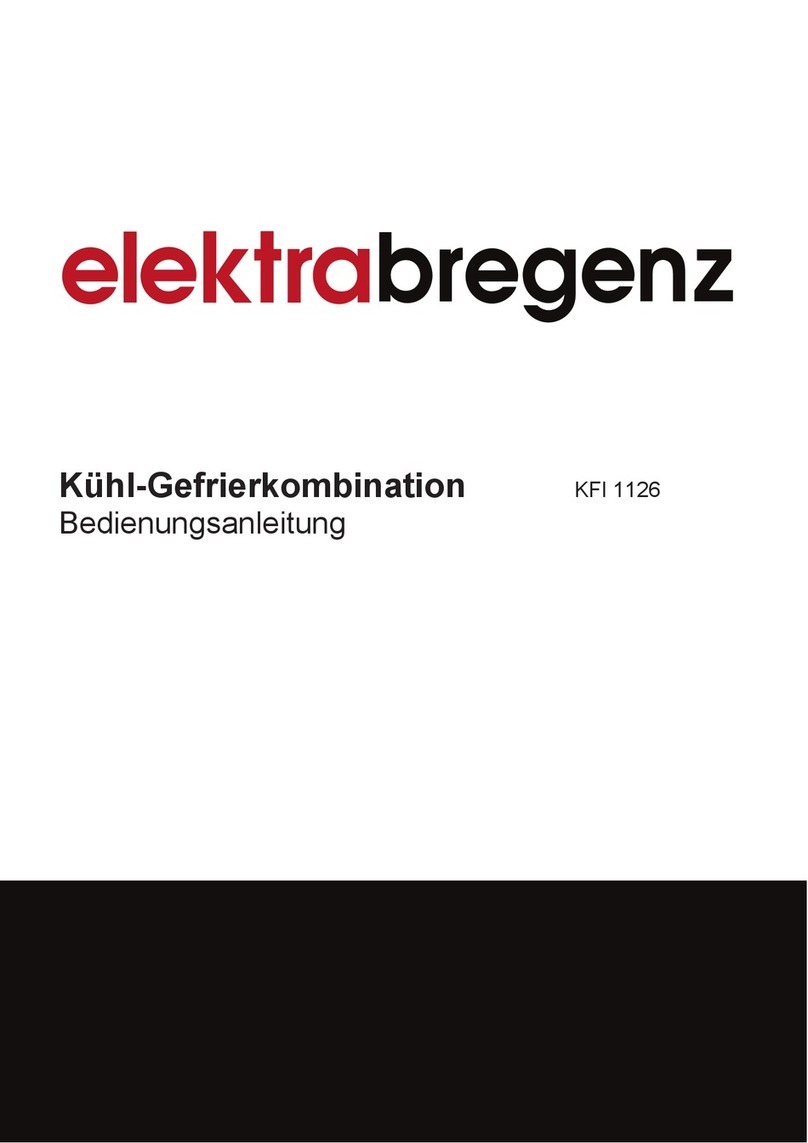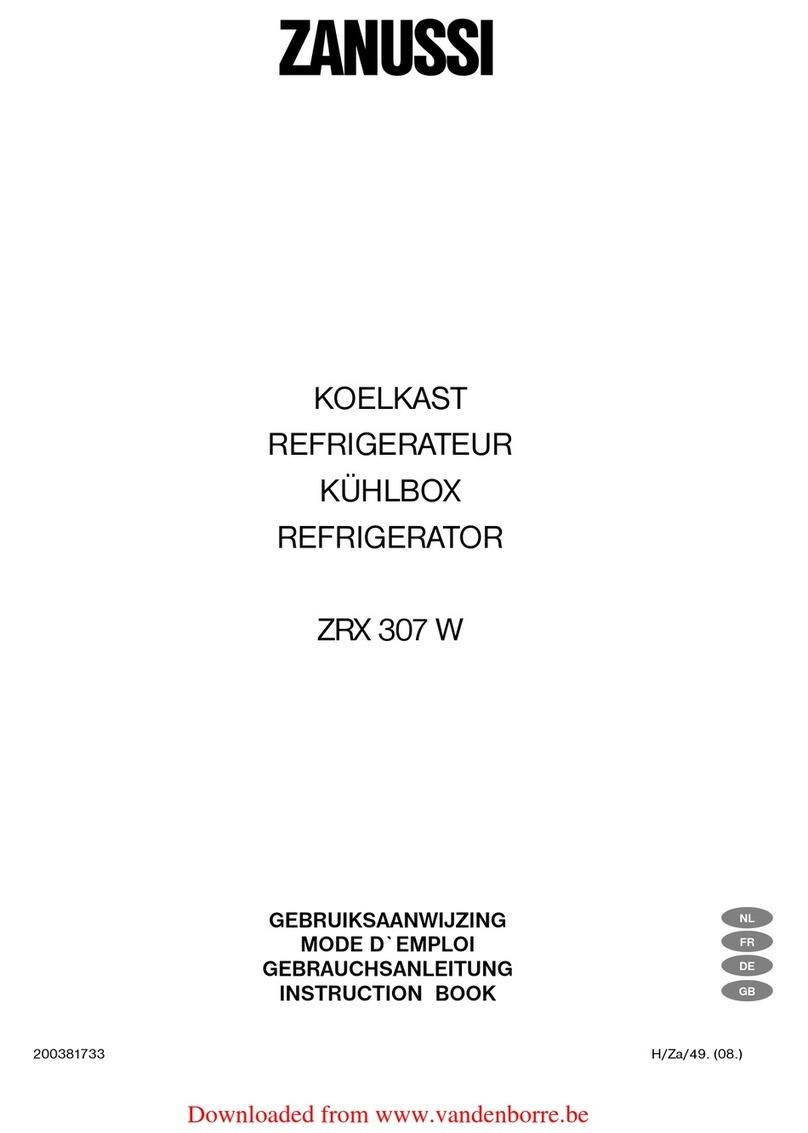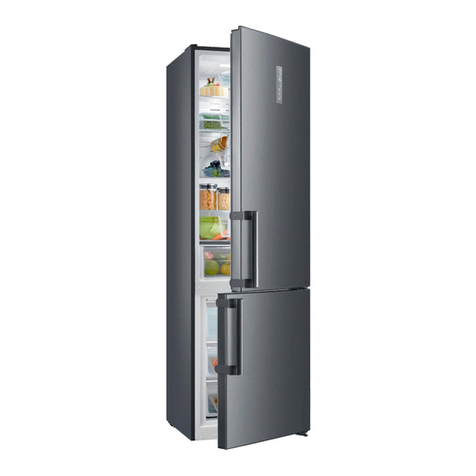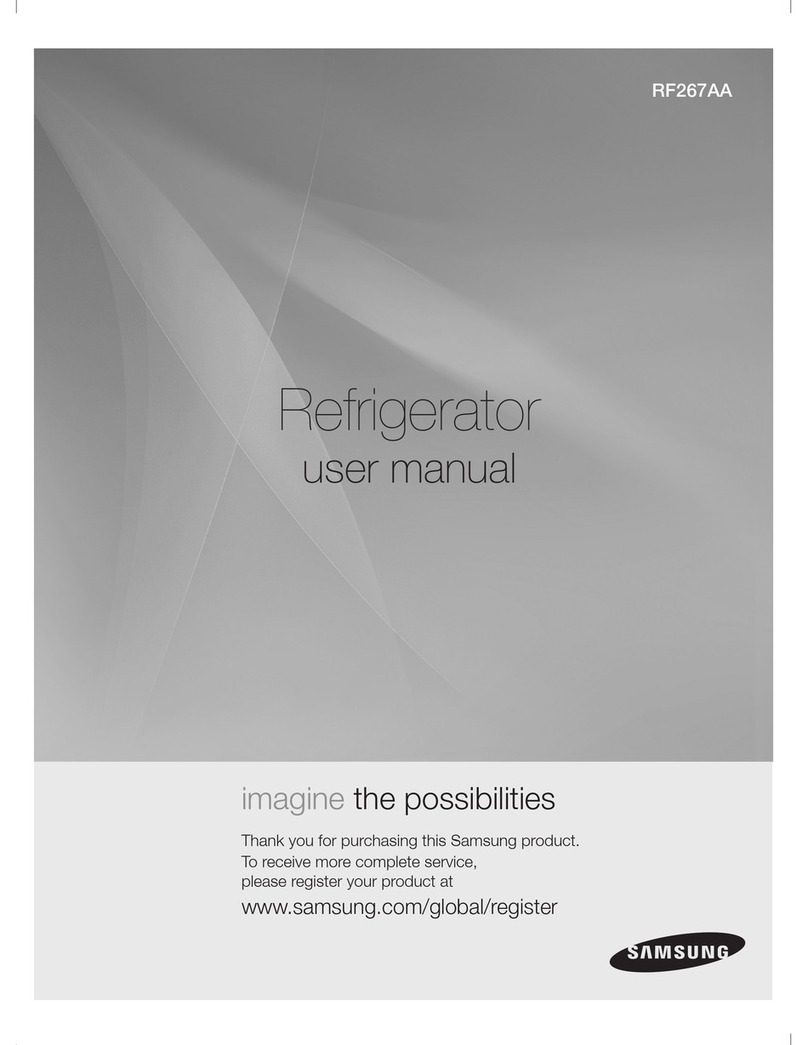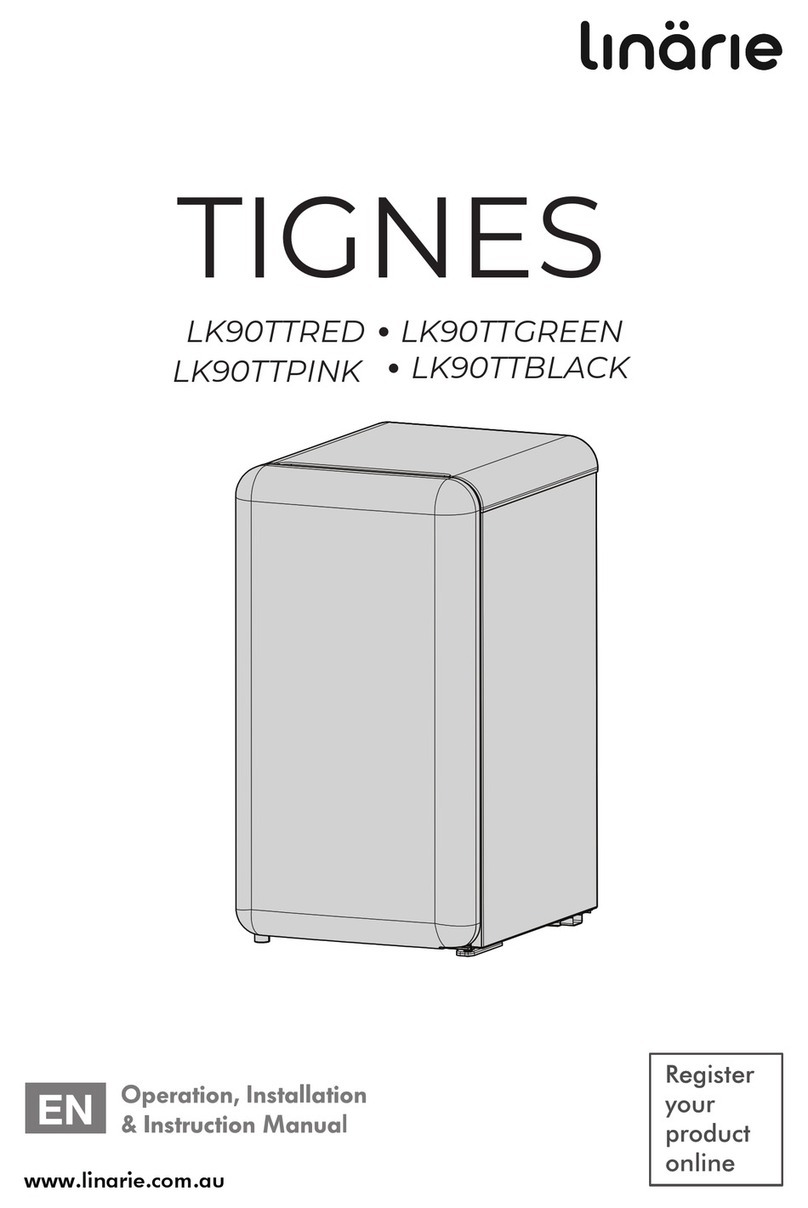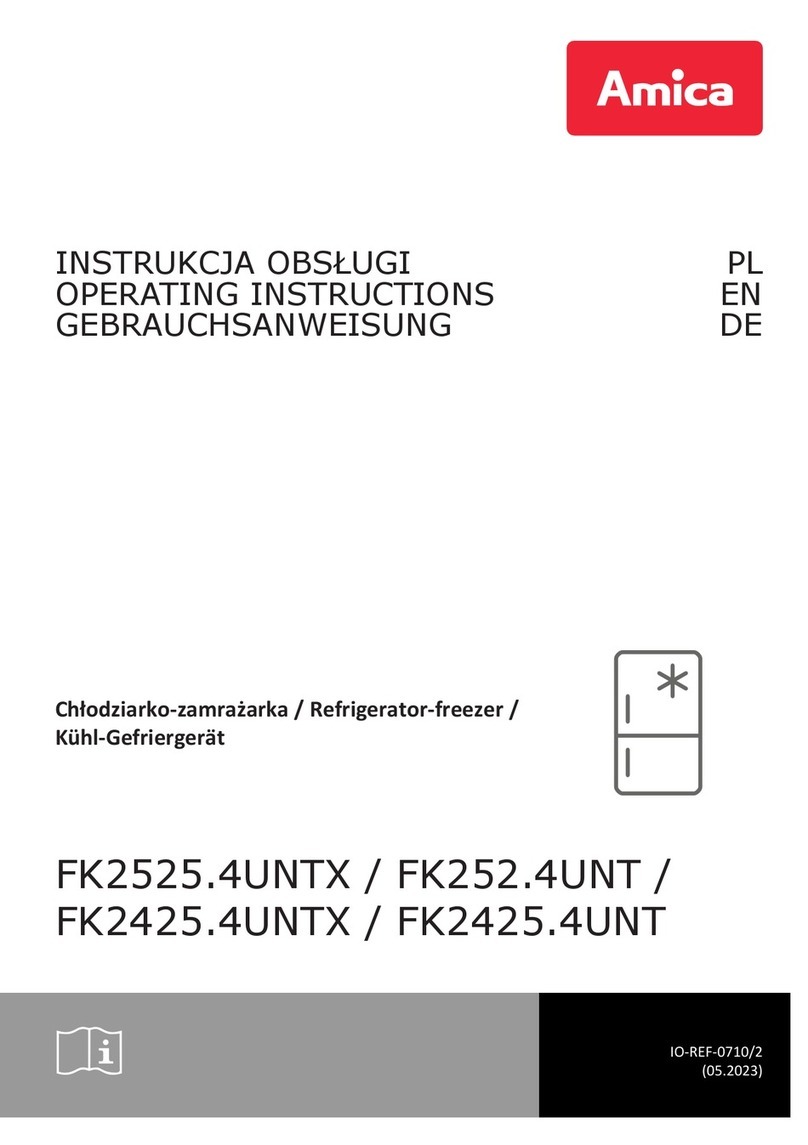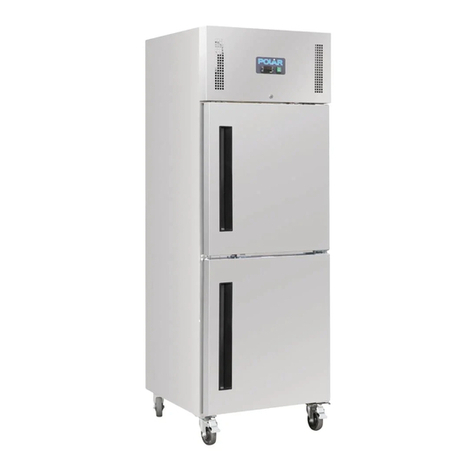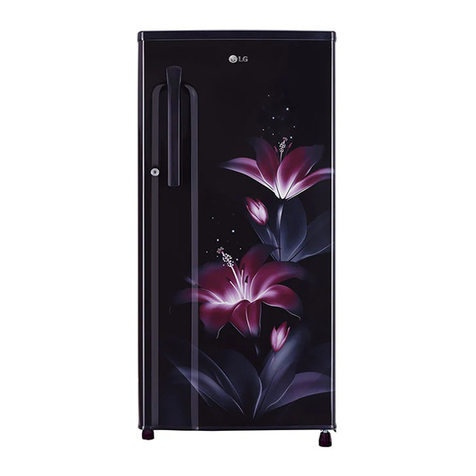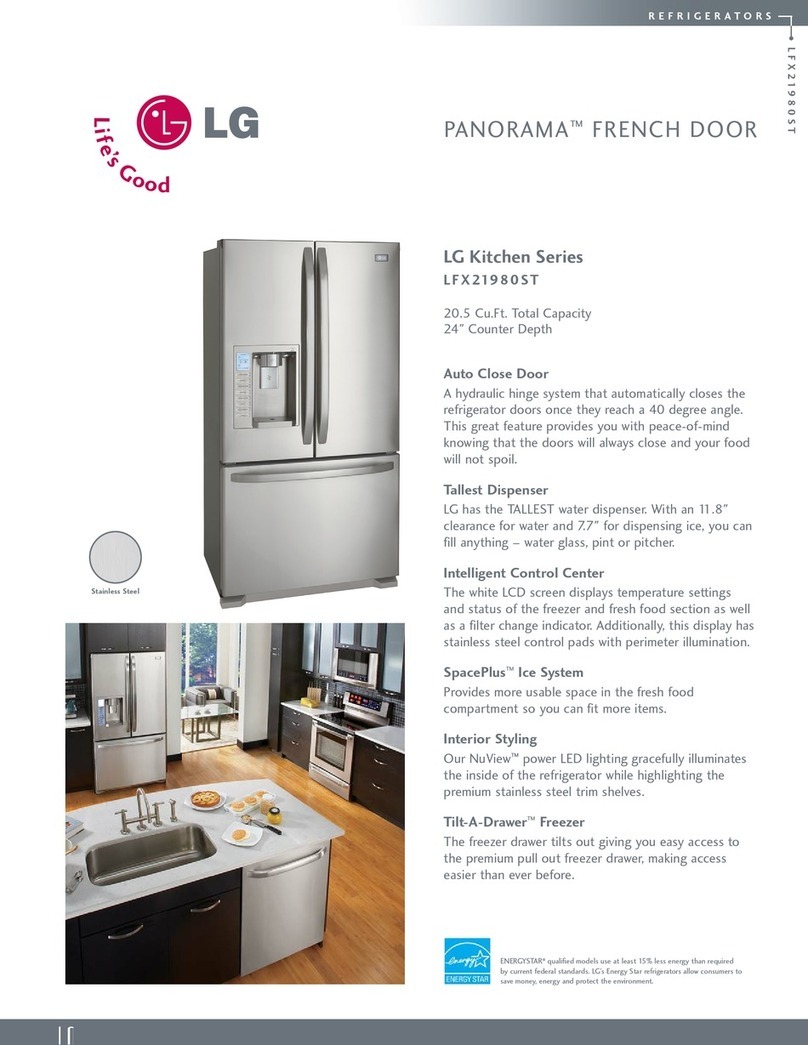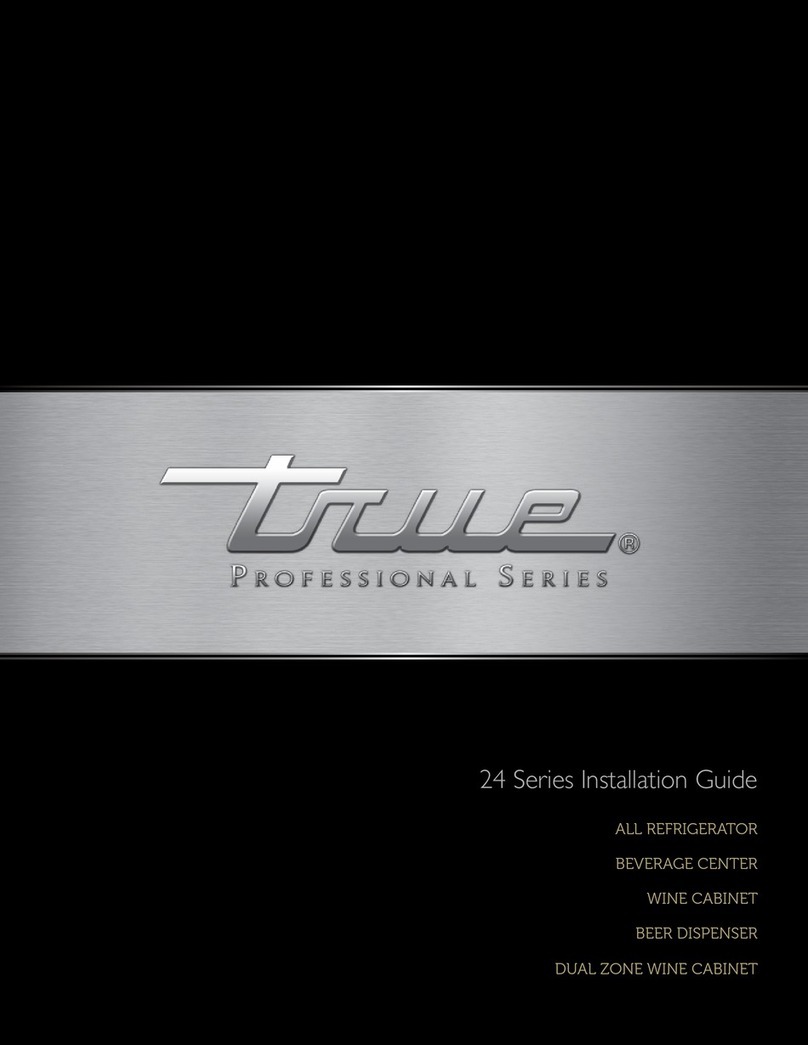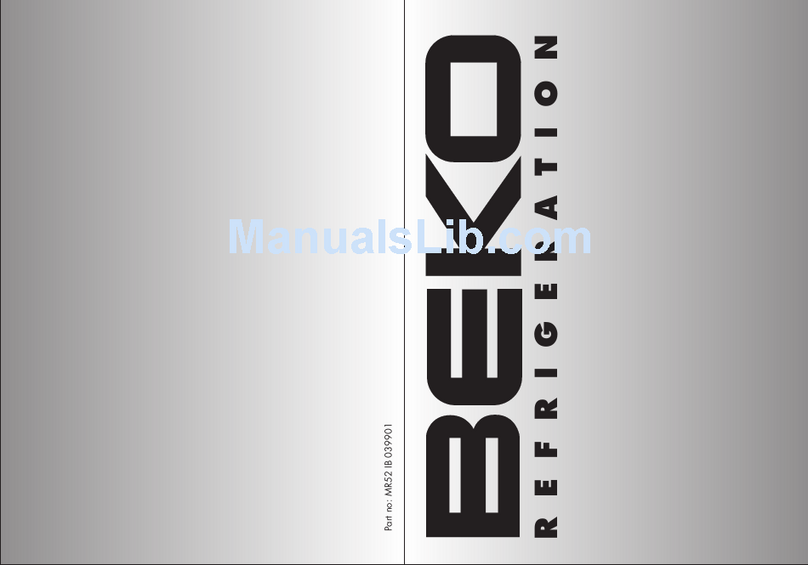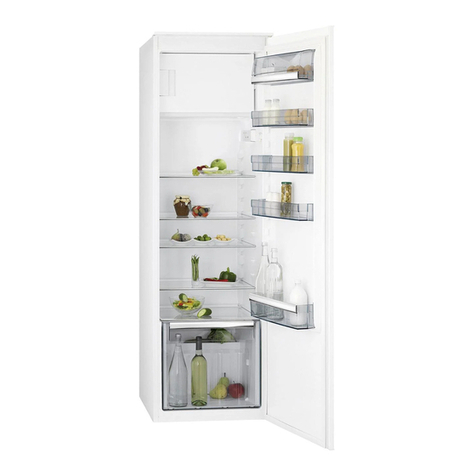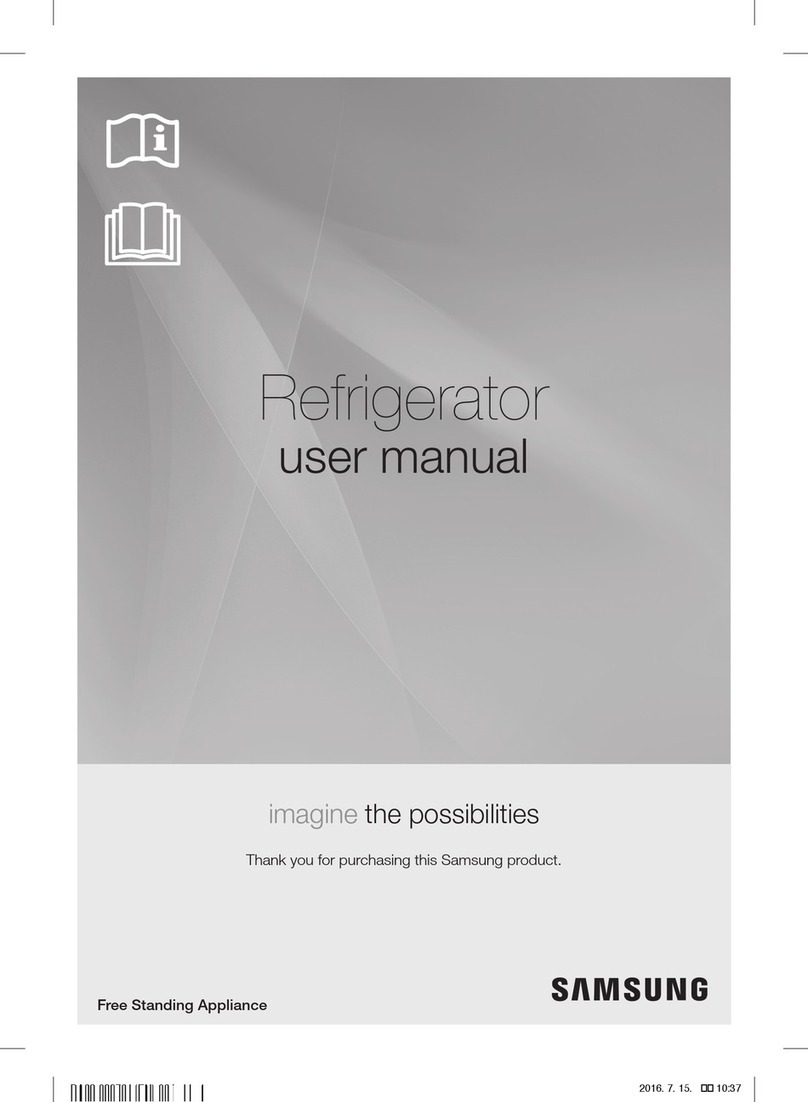Elektra Bregenz KFI 2140-1 User manual

2223 303-51
elektrabregenz
Gebrauchsanweisung und
Einbauanweisung
(Operating and Installation
Instructions)
(Kühl- Gefriergerät)
(Fridge-Freezer)
KFI 140-1
elektrabregenz
Elektra Bregenz Aktiengesellschaft
Josef-Heiß-Straße 1
Postfach 150
A- 6130 Sch az
Telefon: 0 52 42/69 40 - 0

2
Inhalt
Sicherheit . . . . . . . . . . . . . . . . . . . . . . . . . . . . . . . . . . . . . . . . . . . . . . . . . . . . . . . . . . . . . . . . . . . 3
Entsorgung . . . . . . . . . . . . . . . . . . . . . . . . . . . . . . . . . . . . . . . . . . . . . . . . . . . . . . . . . . . . . . . . . 4
Information zur Geräteverpackung . . . . . . . . . . . . . . . . . . . . . . . . . . . . . . . . . . . . . . . . . . . . . . . . . 4
Entsorgung von Altgeräten . . . . . . . . . . . . . . . . . . . . . . . . . . . . . . . . . . . . . . . . . . . . . . . . . . . . . . . 4
Transportschutz entfernen . . . . . . . . . . . . . . . . . . . . . . . . . . . . . . . . . . . . . . . . . . . . . . . . . . . . . 4
Transportsicherungen . . . . . . . . . . . . . . . . . . . . . . . . . . . . . . . . . . . . . . . . . . . . . . . . . . . . . . . . . . . 4
Aufstellen . . . . . . . . . . . . . . . . . . . . . . . . . . . . . . . . . . . . . . . . . . . . . . . . . . . . . . . . . . . . . . . . . . . 4
Aufstellort . . . . . . . . . . . . . . . . . . . . . . . . . . . . . . . . . . . . . . . . . . . . . . . . . . . . . . . . . . . . . . . . . . . . 4
Ihr Kühlgerät braucht Luft . . . . . . . . . . . . . . . . . . . . . . . . . . . . . . . . . . . . . . . . . . . . . . . . . . . . . . . . 5
Türanschlag wechseln . . . . . . . . . . . . . . . . . . . . . . . . . . . . . . . . . . . . . . . . . . . . . . . . . . . . . . . . . 5
Nischenmaße . . . . . . . . . . . . . . . . . . . . . . . . . . . . . . . . . . . . . . . . . . . . . . . . . . . . . . . . . . . . . . . . . 5
An eisungen für den integrierten Einbau . . . . . . . . . . . . . . . . . . . . . . . . . . . . . . . . . . . . . . . . . . . 5
Vor Inbetriebnahme. . . . . . . . . . . . . . . . . . . . . . . . . . . . . . . . . . . . . . . . . . . . . . . . . . . . . . . . . . . . 8
Elektrischer Anschluß . . . . . . . . . . . . . . . . . . . . . . . . . . . . . . . . . . . . . . . . . . . . . . . . . . . . . . . . . . 8
Inbetriebnahme und Temperaturregelung . . . . . . . . . . . . . . . . . . . . . . . . . . . . . . . . . . . . . . . . . 8
Innenausstattung . . . . . . . . . . . . . . . . . . . . . . . . . . . . . . . . . . . . . . . . . . . . . . . . . . . . . . . . . . . . . 9
Abstellflächen . . . . . . . . . . . . . . . . . . . . . . . . . . . . . . . . . . . . . . . . . . . . . . . . . . . . . . . . . . . . . . . . . 9
Türsteller . . . . . . . . . . . . . . . . . . . . . . . . . . . . . . . . . . . . . . . . . . . . . . . . . . . . . . . . . . . . . . . . . . . . . 9
Richtig lagern . . . . . . . . . . . . . . . . . . . . . . . . . . . . . . . . . . . . . . . . . . . . . . . . . . . . . . . . . . . . . . . .10
Einfrieren und Tiefkühllagern . . . . . . . . . . . . . . . . . . . . . . . . . . . . . . . . . . . . . . . . . . . . . . . . . . . 10
Eiswürfel bereiten . . . . . . . . . . . . . . . . . . . . . . . . . . . . . . . . . . . . . . . . . . . . . . . . . . . . . . . . . . . . . 10
Abtauen . . . . . . . . . . . . . . . . . . . . . . . . . . . . . . . . . . . . . . . . . . . . . . . . . . . . . . . . . . . . . . . . . . . . . 11
Gerät abschalten . . . . . . . . . . . . . . . . . . . . . . . . . . . . . . . . . . . . . . . . . . . . . . . . . . . . . . . . . . . . . 12
Reinigung und Pflege . . . . . . . . . . . . . . . . . . . . . . . . . . . . . . . . . . . . . . . . . . . . . . . . . . . . . . . . . 12
Tips zur Energie-Einsparung . . . . . . . . . . . . . . . . . . . . . . . . . . . . . . . . . . . . . . . . . . . . . . . . . . . 12
Was tun, wenn . . . . . . . . . . . . . . . . . . . . . . . . . . . . . . . . . . . . . . . . . . . . . . . . . . . . . . . . . . . . . . . 13
Abhilfe bei Störungen . . . . . . . . . . . . . . . . . . . . . . . . . . . . . . . . . . . . . . . . . . . . . . . . . . . . . . . . . . . 13
Lampe aus echseln. . . . . . . . . . . . . . . . . . . . . . . . . . . . . . . . . . . . . . . . . . . . . . . . . . . . . . . . . . . . 14
Bestimmungen, Normen, Richtlinien . . . . . . . . . . . . . . . . . . . . . . . . . . . . . . . . . . . . . . . . . . . . . 14
Garantieurkunde . . . . . . . . . . . . . . . . . . . . . . . . . . . . . . . . . . . . . . . . . . . . . . . . . . . . . . . . . . . . . . 28
Kundendienst . . . . . . . . . . . . . . . . . . . . . . . . . . . . . . . . . . . . . . . . . . . . . . . . . . . . . . . . . . . . . . . .29
Sehr geehrte Kundin, sehr geehrter
Kunde,
bevor Sie Ihr neues Kältegerät in Betrieb nehmen,
lesen Sie bitte diese Gebrauchsan eisung aufmerk-
sam durch. Sie enthält ichtige Informationen zum
sicheren Gebrauch, zum Aufstellen und zur Pflege
des Gerätes.
Be ahren Sie bitte die Gebrauchsan eisung zum
späteren Nachschlagen auf. Geben Sie sie an even-
tuelle Nachbesitzer des Gerätes eiter.
Mit dem Warndreieck und/oder durch Signal-
örter (Warnung!, Vorsicht!, Achtung!) sind Hin-
eise hervorgehoben, die für Ihre Sicherheit oder
für die Funktionsfähigkeit des Gerätes ichtig
sind. Bitte unbedingt beachten.
Gedruckt auf um eltschonend hergestelltem Papier
– er ökologisch denkt, handelt auch so ...
Nach diesem Zeichen erhalten Sie ergänzen-
de Informationen zur Bedienung und praktischen
An endung des Gerätes.
Mit dem Kleeblatt sind Tips und Hin eise zum
irtschaftlichen und um eltschonenden Einsatz
des Gerätes gekennzeichnet.
Für evtl. auftretende Störungen enthält die
Gebrauchsan eisung Hin eise zur selbständigen
Behebung, siehe Abschnitt "Was tun, enn ...". Soll-
ten diese Hin eise nicht ausreichen, steht Ihnen
unser Kundendienst jederzeit zur Verfügung.

3
in andere lebensgefährliche Situationen geraten.
• Kinder können Gefahren, die im Umgang mit
Haushaltsgeräten liegen, oft nicht erkennen. Sor-
gen Sie deshalb für die not endige Aufsicht und
lassen Sie Kinder nicht mit dem Gerät spielen!
Im Alltagsbetrieb
• Behälter mit brennbaren Gasen oder Flüssigkei-
ten können durch Kälteein irkung undicht er-
den. Explosionsgefahr! Lagern Sie keine Behälter
mit brennbaren Stoffen, ie z.B. Spraydosen,
Feuerzeug-Nachfüllkartuschen etc. im Kältegerät.
• Flaschen und Dosen dürfen nicht in den Gefrier-
raum. Sie können springen, enn der Inhalt
gefriert - bei kohlensäurehaltigem Inhalt sogar
explodieren! Legen Sie nie Limonaden, Säfte,
Bier, Wein, Sekt us . in den Gefrierraum. Aus-
nahme: Hochprozentige Spirituosen können im
Gefrierraum gelagert erden.
• Speiseeis und Eis ürfel nicht unmittelbar aus
dem Gefrierraum in den Mund nehmen. Sehr kal-
tes Eis kann an Lippen oder Zunge festfrieren
und Verletzungen verursachen.
• Tiefkühlgut nicht mit nassen Händen berühren. Die
Hände könnten daran festfrieren.
• Keine Elektrogeräte (z. B. elektrische Eismaschi-
nen, Rührgeräte etc.) im Kältegerät betreiben.
• Vor Reinigungsarbeiten das Gerät grundsätzlich
abschalten und den Netzstecker ziehen oder
Sicherung in der Wohnung abschalten bz . her-
ausdrehen.
• Netzstecker immer am Stecker aus der Steckdo-
se ziehen, nie am Kabel.
Im Störungsfall
• Sollte einmal eine Störung am Gerät auftreten,
sehen Sie bitte zuerst in dieser Gebrauchsan ei-
sung unter "Was tun, enn ..." nach. Falls die
dort aufgeführten Hin eise nicht eiterhelfen,
führen Sie bitte keine eiteren Arbeiten selbst
aus.
• Kältegeräte dürfen nur von Fachkräften repariert
erden. Durch unsachgemäße Reparaturen kön-
nen erhebliche Gefahren entstehen. Wenden Sie
sich im Reparaturfall bitte an Ihren Fachhändler
oder an unseren Kundendienst.
Die Sicherheit unserer Kältegeräte entspricht den
anerkannten Regeln der Technik und dem Gerätesi-
cherheitsgesetz. Dennoch sehen ir uns veranlaßt,
Sie mit folgenden Sicherheitshin eisen vertraut zu
machen:
Bestimmungsgemäße Verwendung
• Das Kältegerät ist für die Ver endung im Haus-
halt bestimmt. Es eignet sich zum Kühlen, Ein-
frieren und Tiefkühllagern von Lebensmitteln
so ie zur Eisbereitung. Wird das Gerät z eckent-
fremdet oder falsch bedient, kann vom Hersteller
keine Haftung für eventuelle Schäden übernom-
men erden.
• Umbauten oder Veränderungen am Kältegerät
sind aus Sicherheitsgründen nicht zulässig.
• Sollten Sie das Kältegerät ge erblich oder für
andere Z ecke als zum Kühlen, Tiefkühllagern
und Einfrieren von Lebensmitteln benutzen,
beachten Sie bitte die für Ihren Bereich gültigen
gesetzlichen Bestimmungen.
Vor der ersten Inbetriebnahme
• Überprüfen Sie das Kältegerät auf Transport-
schäden. Ein beschädigtes Gerät auf keinen Fall
anschließen! Wenden Sie sich im Schadensfall
bitte an den Lieferanten.
Kältemittel
Das Gerät enthält im Kältemittelkreislauf das Kälte-
mittel Isobutan (R600a), ein Naturgas mit hoher
Um eltverträglichkeit, das jedoch brennbar ist.
• Achten Sie beim Transportieren und Aufstellen
des Gerätes darauf, daß keine Teile des Kältemit-
telkreislaufs beschädigt erden.
• Bei Beschädigung des Kältemittelkreislaufs:
– offenes Feuer und Zündquellen unbedingt ver-
meiden;
– den Raum, in dem das Gerät steht, gut durch-
lüften.
Sicherheit von Kindern
• Verpackungsteile (z. B. Folien, Styropor) können
für Kinder gefährlich sein. Erstickungsgefahr! Ver-
packungsmaterial von Kindern fernhalten!
• Ausgediente Altgeräte bitte vor der Entsorgung
unbrauchbar machen. Netzstecker ziehen, Netzka-
bel durchtrennen, eventuell vorhandene Schnapp-
oder Riegelschlösser entfernen oder zerstören.
Dadurch verhindern Sie, daß sich spielende Kin-
der im Gerät einsperren (Erstickungsgefahr!) oder
Sicherheit

4
Information zur Geräteverpackung
Alle ver endeten Werkstoffe sind um eltverträglich!
Sie können gefahrlos deponiert oder in der Müllver-
brennungsanlage verbrannt erden!
Zu den Werkstoffen: Die Kunststoffe können auch
iederver ertet erden und sind folgendermaßen
gekennzeichnet:
>PE< für Polyäthylen, z. B. bei der äußeren Hülle und
den Beuteln im Innern.
>PS< für geschäumtes Polystyrol, z. B. bei den Pol-
sterteilen, grundsätzlich FCKW-frei.
Die Kartonteile erden aus Altpapier hergestellt und
sollten auch ieder zur Altpapiersammlung gegeben
erden.
Entsorgung von Altgeräten
Aus Um eltschutzgründen müssen Kältegeräte fach-
gerecht entsorgt erden. Dies gilt für Ihr bisheriges
Gerät und - nachdem es eines Tages ausgedient hat
- auch für Ihr neues Gerät.
Warnung! Ausgediente Altgeräte bitte vor der
Entsorgung unbrauchbar machen. Netzstecker
ziehen, Netzkabel durchtrennen, eventuell vorhan-
dene Schnapp- oder Riegelschlösser entfernen oder
zerstören. Dadurch verhindern Sie, daß sich spie-
lende Kinder im Gerät einsperren (Erstickungsge-
fahr!) oder in andere lebensgefährliche Situationen
geraten.
Entsorgungshinweise:
• Das Gerät darf nicht mit dem Haus- oder Sperr-
müll entsorgt erden.
• Der Kältemittelkreislauf, insbesondere der Wär-
metauscher an der Geräterückseite, darf nicht
beschädigt erden.
• Auskunft über Abholtermine oder Sammelplätze
erhalten Sie bei der örtlichen Stadtreinigung oder
der Gemeindever altung.
Entsorgung
Das Gerät so ie Teile der Innenausstattung sind für
den Transport geschützt.
• Klebebänder links und rechts an den Türaußensei-
ten abziehen.
• Alle Klebebänder so ie Polsterteile aus
dem Geräteinnenraum entfernen.
Transportsicherungen
Ihr Gerät ist mit Transportsicherung versehen, die
die Ablage ährend des Transportes sichern.
Entfernen Sie diese ie folgt:
Transportschutz entfernen
Klimaklasse für Umgebungstemperatur von
SN +10 bis +32 °C
N+16 bis +32 °C
ST +18 bis +38 °C
T+18 bis +43 °C
Aufstellort
Das Gerät soll in einem gut belüfteten und trockenen
Raum stehen.
Die Umgebungstemperatur irkt sich auf den Strom-
verbrauch aus. Daher sollte das Gerät
– nicht direkter Sonneneinstrahlung ausgesetzt
sein;
– nicht an Heizkörpern, neben einem Herd oder
sonstigen Wärmequellen stehen;
– nur an einem Ort stehen, dessen Umgebung-
stemperatur der Klimaklasse entspricht, für die
das Gerät ausgelegt ist.
Die Klimaklasse finden Sie auf dem Typschild, das
sich links im Innenraum des Kühlraumes befindet.
Nachstehende Tabelle zeigt, elche Umgebungstem-
peratur elcher Klimaklasse zugeordnet ist:
Aufstellen
Ist die Aufstellung neben einer Wärmequelle unver-
meidbar, sind folgende seitliche Mindestabstände
einzuhalten:
– zu Elektroherden 3 cm;
– zu Öl- und Kohleherden 30 cm.
Können diese Abstände nicht eingehalten erden, ist
eine Wärmeschutzplatte z ischen Herd und Kälte-
gerät erforderlich.
Steht das Kältegerät neben einem anderen Kühl-
oder Gefriergerät, ist ein seitlicher Abstand von 5 cm
erforderlich, damit sich an den Geräte-Außenseiten
kein Sch itz asser bildet.
B
A
Ablagen hinten hochheben, in Pfeilrichtung ziehen
bis sich die Ablage löst und die Sicherungen ent-
fernen.
KUNDENSERVICE
Vorarlberg
Telefon: 05574/64500; Fax: 05242/9003-184
Steiermark / Kärnten / Osttirol
80 0 Graz; Elisabethinergasse 22;
Telefon: 0 316/ 71 45 11; Fax: 0 316/ 71 13 09
Oberösterreich / Salzburg
40 0 Linz; Fichtenstraße 4;
Telefon: 0 732/ 34 95 01; Fax: 0 732/ 33 00 93
Tirol
Schwaz; Josef-Heiß-Straße 1;
Telefon: 0 52 42/ 9003-1650; Fax: 0 52 42/ 9003-184
Wien / Niederösterreich
1 3 Wien; Pfarrgasse 77;
Telefon: 01/ 61 016; Fax: 01/ 61 016-61
070 Retz; Fladnitzer eg 30;
Telefon: 0 29 42/ 27 31; Fax: 0 29 42/ 28 991

5
Ihr Kühlgerät braucht Luft
Aus Gründen der Sicherheit muß eine Mindestbelüf-
tungsheit gesichert sein, ie aus der Abb. hervorgeht:
Achtung:
Die Lüftungs-Öffnungen müs sen immer sauber-
gehalten werden. Damit die Luft zirkulieren kann,
die Lüftungsöffnungen niemals abdecken oder
verstellen.
Türanschlag wechseln
Das Gerät wird mit Türanschlag von
rechts geliefert. Falls einen Türanschlag links
erfordert wird; gehen Sie wie folgt vor bevor Sie
das Gerät einbauen.
1. Obere Scharnierstift abschrauben und Kun-
stoffteil entfernen.
2. Obere Tür abnehmen.
3. Mittlere Scharnier abschrauben und auf
gegenüberliegende Seite ieder anschrauben.
4. Obere Tür ieder einsetzen.
5. Oberen Scharnierstift mit den Kunstoffteil und
auf gegenüberliegende Seite ieder anmontie-
ren.
5. Untere Scharnierstift abschrauben und Kun-
stoffteil entfernen und auf gegenüberliegende
Seite ieder anmontieren.
Anweisungen für den integrierten
Einbau
D765
Fugenabdeckprofil am Gerät, ie in Abbildung
gezeigt ankleben.
Nischenmaße
Höhe 1225 mm
Tiefe 550 mm
Breite 560 mm
50 mm
min.
200 cm
2
200 cm
2
min.
D567
28
GARANTIEURKUNDE
Für unsere Geräte übernehmen ir die Garantie zu den nachfolgend aufgeführten Bedin-
gungen:
1. elektrabregenz ge ährt eine Garantie von 24 Monaten, gerechnet vom Tag, der Lie-
ferung an den Endverbraucher. Der maschinell erstellte Kaufbeleg dient als Nach eis.
Diese Garantiezusage gilt nur gegenüber Endabnehmern bei nicht ge erblicher Nut-
zung, die Erstkäufer unserer Geräte vom Händler sind.
2. Durch die Garantie ist die gesetzliche Ge ährleistungspflicht nicht eingeschränkt.
3. Innerhalb der Garantiezeit ird unser Kundendienst Mängel des Gerätes, die nach-
eislich auf Material- oder Fertigungsfehler zurückzuführen sind, nach Prüfung der
Verhähltnismäßigkeit beheben. Die Entscheidung elche Art der Nachbesserung
erfolgt liegt ausschließlich bei elektrabregenz. Wir übernehmen die für die Beseiti-
gung des Mangels anfallenden Kosten für Arbeitszeit und Material.
4. Unsere Garantieleistung erfolgt nur, enn das Gerät sachgemäß und unter Beachtung
unserer Auf- und Einbauvorschriften behandelt urde. Unsere Garantie erstreckt sich
nicht auf leicht zerbrechliche Teile aus Glas oder Kunststoff, so ie Verbrauchsteile,
ie z. B. Aktivkohlefilter, Glimmlampen, Glühbirnen, etc. so ie Schäden, die durch
abnorme Bedingungen in der Strom- bz . Wasserzufuhr oder durch höhere Ge alt
verursacht erden.
Transportschäden fallen nicht unter diese Garantie.
Schäden außerhalb des Gerätes, so ie Schäden durch Eingriffe bz . Reparaturen
von Personen, die nicht durch elektrabregenz ermächtigt urde, sind von der Garan-
tieleistung ausgeschlossen.
5. Garantiepflichtige Mängel müssen unverzüglich der nächstgelegenen elektrabregenz
- Kundendienststelle unter Vorlage des Kaufbeleges gemeldet erden.
6. Durch Garantieleistungen ird die Garantiefrist des Gerätes nicht verlängert. Bitte
überprüfen Sie das Gerät sofort nach Übernahme und melden Sie eventuelle Fehler
innerhalb von 14 Tagen.
Wir danken Ihnen, daß Sie ein Qualitätsprodukt von elektrabregenz er orben haben
und ünschen Ihnen viel Freude!

6
Gerät mit den 4 beiliegenden Schrauben befestigen.
(I = 3,5 x 13)
B
E
C
D
In die Befestigungs- und Scharnierlöcher beiliegende
Abdeckkappen (C-D) einsetzen.
Belüftungsgitter (B) und Scharnierabdeckung (E) auf-
stecken.
Die Schiene (Ha) auf der Innenseite der Möbeltür
oben und unten auflegen (siehe Abb.) und die Posi-
tion der äußeren Bohrlöcher anzeichnen. Nachdem
die Löcher gebohrt urden, die Schiene mit den
mitgelieferten Schrauben befestigen.
21 mm
21mm
ca. 50 mm
90°
90°
ca. 50 mm
PR266
Ha Hb
Hc
Hd
Die Teile Ha, Hb, Hc, Hd abnehmen, ie in der Abb.
gezeigt ird.
Gerät in die Nische einschieben, bis die Anschlagleiste (1)
oben am Möbel anliegt und die vordere Kante des
Scharniers mit der Türöffnungsseite bündig an der Nis-
chenseiten and ansteht (2).
D023
1
2
I
27
Changing the light bulb
Warning! There is a risk of electric shocks!
Before changing the light bulb, s itch off the
appliance and unplug it, or pull the fuse or the cir-
cuit breaker.
Light bulb data:Replace the lamp ith one of the
same po er (the maximum po er is sho n on
the light diffuser).
1. To s itch off the appliance, turn the temperature
regulator to position "0".
2. Unplug the mains plug.
3. To change the light bulb, undo the scre .
4. Press the light bulb cover as sho n and slide it
back ards.
5. Change the defective light bulb.
6. Refit the light bulb cover and the scre .
7. Put the refrigerator back into operation.
D411
This appliance as designed for household use
and as manufactured in accordance ith the
appropriate standards. The necessary measures
in accordance ith appliance safety legislation
regulations (GSG), accident prevention regulations
for refrigeration appliances (VBG 20) and the regu-
lations of the German Society of Electrical Engi-
neers (VDE) ere observed in the manufacture of
this appliance.
The refrigerant circuit has been checked for leaks.
This appliance is in accordance ith the follo ing
EU guidelines:
– 73/23/EWG dated 19 February 1973 - lo
voltage guidelines.
– 89/336/EWG dated 3 May 1989
(including guideline change notice 92/31/EWG)
- EMV guideline
Regulations, Standards, Guidelines

7
Gerätetür und Möbeltür auf ca. 90° öffnen. Den
Winkel (Hb) in der Schiene (Ha) einsetzen.
Gerätetür und Möbeltür zusammenhalten und die
Bohrlöcher anzeichnen (siehe Abb.).
PR167
Ha
Hb
8mm
PR168
Hb
PR167/1
Hd
Hb
Den Winkel ieder auf der Schiene anbringen und
mit den mitgelieferten Schrauben befestigen.
Für eine allfällig not endige Ausrichtung der
Möbeltür, den Spielraum der Langlöcher nutzen.
Nach Beendigung der Arbeiten den ein andfreien
Verschluß der Gerätetür überprüfen.
Die Abdeckung (Hd) in die Schiene (Hb) eindrück-
en, bis sie einrastet.
PR33
Hc
Ha
Die Abdeckung (Hc) in die Schiene (Ha) eindrücken,
bis sie einrastet.
Ha
8mm
K
Die Winkeleisen entfernen und 8 mm vom äusseren Rand
der Tür mit dem Nagel (K) kennzeichnen.
26
Malfunction Possible Cause Remedy
Appliance does not ork.
Appliance is not s itched on Switch on the appliance.
The food is too warm..
Mains plug is not plugged in or is loose. Insert mains plug.
Fuse has blown or is defective Sicherung überprüfen, gegebenenfalls
erneuern.
Interior lighting does not work.
Socket is defective. Mains malfunctions are to be corrected by an
electrician.
Appliance cools too much Temperature is set too cold. Turn the temperature regulator to a warmer
setting temporarily..
The appliance is near a heat source.
Temperature is not properly adjusted. lease look in the "Initial Start Up" section.
Light bulb is defective..lease look in the "Changing the Light Bulb"
section.
Turn the temperature regulator to a colder set-
ting temporarily.
Door was open for an extended period.
lease look in the "Installation location" sec-
tion.
A large quantity of warm food was placed in
the appliance within the last 24 hours.
Open the door only as long as necessary.
Heavy build up of frost, possibly also on the
door seal.
Door seal is not air tight (possibly after chan-
ging over the hinges).
Carefully warm the leaking sections of the
door seal with a hair dryer (not hotter than
approx. 50 °C). At the same time shape the
warmed door seal by hand such that it sits
correctly.
Unusual noises.
The appliance is touching the wall or other
objects.
Appliance is not level.
A component, e.g. a pipe, on the rear of the
appliance is touching another part of the
appliance or the wall.
If necessary, carefully bend the component out
of the way.
Move the appliance slightly.
Readjust the feet.
The compressor starts after a period of time.
See the "Cleaning and Care" section.
This is normal, no error has occurred.The compressor does not start immediately
after changing the temperature setting.
Water on the floor or on storage shelves. Water drain hole is blocked.
Correcting Malfunctions
A malfunction may be caused by only a minor fault
that you can rectify yourself using the follo ing
instructions. Do not perform any other ork on the
appliance if the follo ing information does not pro-
vide assistance in your specific case.
What to do if ...
Warning! Repairs to refrigerators/freezers may
only be performed by qualified service engineers.
Improper repairs can give rise to significant
hazards for the user.If your appliance needs repai-
ring, please contact your specialist dealer or our
Customer Service.

• Das Geräteinnere und alle Ausstattungsteile bitte
vor Erstinbetriebnahme reinigen (siehe Abschnitt
"Reinigung und Pflege").
Elektrischer Anschluß
Für den elektrischen Anschluß ist eine vorschrifts-
mäßig installierte Schutzkontakt-Steckdose erforder-
lich. Sie sollte so gesetzt sein, daß ein Ziehen des
Netzsteckers möglich ist.
Die elektrische Absicherung muß mindestens 10/16
Ampere betragen.
Ist die Steckdose bei eingebautem Gerät nicht mehr
zugänglich, muß eine geeignete Maßnahme in der
Elektroinstallation sicherstellen, daß das Gerät vom
• Netzstecker in die Steckdose stecken. Die Innen-
beleuchtung leuchtet bei geöffneter Tür. Der
Drehknopf für die Temperatur ahl ist im Kühl-
raum rechts.
Stellung „0“ bedeutet: aus.
Stellung „1“ bedeutet: Höchste Innentemperatur
( ärmste Einstellung).
Stellung „6“ (Endanschlag) bedeutet: Tiefste
Innentemperatur (kälteste Einstellung).
Folgende Einflüsse sind ausschlaggebend für die
Innentemperatur:
– Umgebungstemperatur;
– Menge und Temperatur der eingelagerten
Lebensmittel;
– Häufiges oder langes Öffnen der Tür.
Vor Inbetriebnahme
Netz getrennt erden kann (z. B. Sicherung, LS-
Schalter, Fehlerstrom-Schutzschalter oder derglei-
chen mit einer Kontaktöffnungs eite von mindestens
3 mm).
• Vor Inbetriebnahme am Typschild des Gerätes
überprüfen, ob Anschlußspannung und Stromart
mit den Werten des Stromnetzes am Aufstellort
übereinstimmen.
Z. B.: AC 220 ... 240 V 50 Hz oder
220 ... 240 V~ 50 Hz
(d. h. 220 bis 240 Volt Wechselstrom, 50 Hertz)
Das Typschild befindet sich links im Innenraum des
Kühlraumes.
Inbetriebnahme und Temperaturregelung
Die Temperaturen im Kühlraum und Gefrierraum las-
sen sich nicht getrennt regeln.
Sollten frische Lebensmittel schnell eingefroren er-
den, kann Stellung „6“ ge ählt erden. Achten Sie
darauf, daß die Temperatur im Kühlraum nicht unter
0°C absinkt und stellen Sie den Temperaturregler
rechtzeitig auf Stellung „3“ oder „4“ zurück.
Wichtig!
Hohe Umgebungstemperatur (z. B. an heißen Som-
mertagen) und kalte Einstellung des Temperaturreg-
lers (Stellung „5“ bis „6“) kann zu Dauerbetrieb des
Kompressors führen.
In diesem Fall den Temperaturregler auf eine ärme-
re Einstellung zurückdrehen (Stellung „3“ bis „4“). Bei
dieser Einstellung ird der Kompressor geregelt und
der Abtauvorgang ieder automatisch eingeleitet.
8
25
• Do not install the appliance near cookers, radia-
tors or other sources of armth. High ambient
temperatures cause longer, more frequent ope-
ration of the compressor.
• Ensure sufficient air circulation and exhaust at the
appliance base and at the back all of the
appliance. Never cover air vent openings.
• Do not place arm foods into the appliance.Allo
arm foods to cool first.
For hygienic reasons the appliance interior, inclu-
ding interior accessories, should be cleaned regu-
larly.
Warning!
• The appliance may not be connected to the mains
during cleaning.Danger of electrical shock! Befo-
re cleaning s itch the appliance offand rem ve
the plug from the mains, or s itch off or turn out
the circuit breaker or fuse.
• Never clean the appliance ith a steam cleaner.
Moisture could accumulate in electrical compo-
nents, danger of electrical shock! Hot vapours
can lead to the damage of plastic parts.
• The appliance must be dry before it is placed
back into service.
Attention!
• Ethereal oils and organic solvents can attack pla-
stic parts, e.g.
– lemon juice or the juice from orange peals;
– butyric acid;
– cleansers hich contain acetic acid.
Do not allo such substances to come into contact
ith appliance parts.
To s itch off the appliance, turn the temperature
regulator to position "0".
If the appliance is not going to be used for an
extended period:
1. Remove all refrigerated and deep-frozen packages
as ell as ice trays.
2. S itch off the appliance by turning the temperature
regulator to position "0".
Switching off the appliance
3. Remove the mains plug or s itch off or turn out the
circuit breaker or fuse.
4. Defrost freezer compartment and clean thoroughly
(see section: “Cleaning and Care”).
5. Leave the door open to avoid the build up of
odours.
Cleaning and Care
• Do not use any abrasive cleansers.
1. Remove frozen food and the food from the refrige-
rator. Wrap frozen food in several layers of ne -
spaper. Store it in a cool place, ell covered.
2. Defrost the freezer compartment prior to cleaning
(see "Defrosting" section).
3. S itch the appliance off and remove the plug from
the mains, or s itch off or turn out the circuit
breaker or fuse.
4. Clean the appliance and the interior accessories
ith a cloth and luke arm ater. Commercially
available dish ashing detergents may also be
used.
5. After cleaning ipe ith fresh ater and rub dry.
Accumulation of dust at the condenser increases
energy consumption. For this reason carefully
clean the condenser at the back of the appliance
once a year ith a soft brush or a vacuum cleaner.
6. Check the ater drain hole on the rear all of the
fridge. Clear a blocked drain hole ith the aid of the
green peg in the pack of accessories included ith
the appliance.
7. After everything is dry place appliance back into
service.
Energy Saving Tips
• Only leave door open as long as necessary.
• Do not set temperature any colder than neces-
sary.
• Keep the heat emitting condenser, the metall gril-
le on the rear all of your appliance, al ays
clean.

9
D338
Verstellung der Abstellflächen
• Eine geschlossene Abstellfläche bitte in die
untersten Führungen über die Obst- und Gemü-
seschalen einschieben. Sie muß immer in dieser
Stellung verbleiben. Die Abstellflächen sind
höhenverstellbar:
• Dazu die Abstellfläche so eit nach vorne zie-
hen, bis sie sich nach oben oder unten
absch enken und herausnehmen läßt.
• Das Einsetzen in eine andere Höhe bitte in
umgekehrter Reihenfolge vornehmen.
• Die vordere Hälfte der VARIO-Glasabstellfläche
auf einer anderen Ebene nach hinten schieben.
Dadurch ge innen Sie Raum, um auf der darun-
terliegenden Abstellfläche hohes Kühlgut abzu-
stellen.
Verstellung der Türabsteller
• Je nach Lagergut können die Türabsteller in
andere Aufnahmen umgesetzt oder heraus-
genommen erden. Kühlgut herausnehmen, Tür-
absteller nach oben drücken, umsetzen und ie-
der eindrücken
Innenausstattung
PRXXX
24
Refrigerator
Frost is automatically eliminated from the evaporator of
the refrigerator compartment every time the motor com-
pressor stops, during normal use. The defrost ater
drains out through a trough into a special container at the
back of the appliance, over the motor compressor, here
it evaporates.
Freezer
The freezer compartment, ho ever, ill become progrssi-
vely covered ith frost. This should be removed ith al pla-
stic scraper, henever the tickness of the frost exceeds 4
mm. During this operation it is not necessary to s itch off the
po er supply or to remove the foodstuffs.Ho ever hen the
ice becomes very thick on the inner liner, complete defro-
sting should be carried out as follo s:
1. Remove the frozen food from the freezer, rap it in
several layers of ne spaper and put it in a very
cool place.
2. S itch off the appliance and pull out the plug, or
remove or unscre the safety fuses.
3. Leave the freezer compartment door open.
4. Turn the thermostat knob to the required setting or
replace the plug in the po er socket.
Warning!
Never use metal tools to scrape off the frost
Do not use a mechanical device or any artificial means to
speed up the tha ing process other than those recom-
mended by the manufacturer.
A temperature rise of the frozen food packs, during defro-
sting , may shorten their safe storage life.
I
Defrosting
D037

10
Eiswürfel bereiten
1. Eis ürfelschale zu 3/4 mit kaltem Wasser füllen,
in den Gefrierraum stellen und gefrieren lassen.
2. Zum Herauslösen der fertigen Eis ürfel die Eis-
ürfelschale ver inden oder kurz unter fließen-
des Wasser halten.
Achtung! Eine eventuell angefrorene Eis ürfelscha-
le keinesfalls mit spitzen oder scharfkantigen Gegen-
ständen ablösen, sonst besteht die Gefahr, daß der
Kältekreislauf beschädigt ird. Ver enden Sie den
beiliegenden Kunststoffschaber.
Um die besten Leistungen des Kühlschrankes zu er-
reichen, beachten Sie bitte folgendes:
• Keine armen Speisen oder Flüssigkeiten in
den Kühlschrank einstellen.
• Geruchverbreitende Lebensmittel sollten abge-
deckt oder einge ickelt erden.
• Die Lebensmittel müssen so eingelagert er-
den, daß die Luft frei zirkulieren kann.
Nachstehend einige praktische Ratschläge:
Fleisch (alle Sorten) in Plastikfolie einpacken und
auf die Glasplatte, die sich über der Gemüseschale
(über den Gemüseschalen) befindet, legen.
In dieser Lage kann das Fleisch längstens 1-
Tage aufbewahrt werden.
Richtig lagern
Gekochte Nahrungsmittel, kalte Platten, usw.
zugedeckt aufbe ahren. Sie können auf jede belie-
bige Ablage gelegt erden.
Obst und Gemüse: nach vorherigem Säubern und
Waschen in der Gemüseschale aufbe ahren
Butter und Käse: in speziellen Behältern aufbe ahren
oder in Alu-bz . Plastikfolie einpacken, um den Kontakt
mit der Luft zu vermeiden.
Milch in Flaschen: gut verschlossen in das Fla-
schenfach an der Innentür stellen
Banane, Kartoffeln, Zwiebeln und Knoblauch
sollten nicht unverpackt im Kühlschrank aufbe-
wahrt werden.
Im Gefrierraum können Sie Tiefkühlkost lagern und
frische Lebensmittel einfrieren.
Achtung!
• Vor dem Einfrieren von Lebensmitteln muß die
Temperatur im Gefrierraum -18 °C oder kälter
sein.
• Bitte das auf dem Typschild angegebene Gefrier-
vermögen beachten. Das Gefriervermögen ist die
maximale Menge an frischer Ware, die innerhalb
von 24 Stunden eingefroren erden kann. Wenn
Sie an mehreren Tagen hintereinander einfrieren,
nehmen Sie bitte nur 2/3 bis 3/4 der auf dem Typ-
schild angegebenen Menge. Sie erreichen eine
bessere Qualität, enn die Lebensmittel schnell
bis zum Kern durchgefroren erden.
• Warme Lebensmittel vor dem Einfrieren abkühlen
lassen. Die Wärme führt zu verstärkter Eisbildung
und erhöht den Energieverbrauch.
• Auf die Lagerzeit bz . auf das Haltbarkeitsdatum
von gekauften Tiefkühlprodukten achten
• Einmal aufgetaute Lebensmittel ohne eitere
Verarbeitung (garen zu Fertiggerichten) auf kei-
nen Fall ein z eites Mal einfrieren.
• Behälter mit brennbaren Gasen oder Flüssigkei-
ten können durch Kälteein irkung undicht er-
den. Explosionsgefahr! Lagern Sie keine Behälter
mit brennbaren Stoffen, ie z.B. Spraydosen,
Feuerzeug-Nachfüllkartuschen etc. im Kältegerät.
• Flaschen und Dosen dürfen nicht in den Gefrier-
raum. Sie können springen, enn der Inhalt
gefriert - bei kohlensäurehaltigem Inhalt sogar
explodieren! Legen Sie nie Limonaden, Säfte,
Bier, Wein, Sekt us . in den Gefrierraum. Aus-
Einfrieren und Tiefkühllagern
nahme: Hochprozentige Spirituosen können im
Gefrierraum gelagert erden.
• Alle Lebensmittel vor dem Einfrieren luftdicht ver-
packen, damit sie nicht austrocknen, nicht den
Geschmack verlieren und keine Geschmacksü-
bertragung auf anderes Tiefkühlgut erfolgen
kann.
Vorsicht! Tiefkühlgut nicht mit nassen Händen
berühren. Die Hände könnten daran festfrieren.
1. Einzufrierende Lebensmittel auf die Ablage
legen. Nicht gefrorene Ware darf bereits gefrore-
ne Ware nicht berühren, die gefrorene Ware kann
sonst antauen.
23
Preparation of Ice Cubes
1. Fill the ice cube tray 3/4 full ith cold ater, place it
in the freezer compartment and leave to freeze.
2. To loosen the frozen cubes, either bend the ice
cube tray or hold it under running ater for a fe
seconds.
Important! Never try to free an ice tray that is fro-
zen to the freezer compartment using pointed or
sharp edged objects.
To obtain the best performance:
• do not store arm food or evaporating liquide in
the refrigeator
• do cover or rap the food, particularly if it has a
strong flavour.
• Position food so that air can circuiate freely round
it.
Useful hints:
Meat (all types): rap in polythene bags and place
on the glass shelf above the vegetable
dra er(s)For safety, store in this way only one
or two days at the most.
Cooked foods, cold dishes, etc: these should be
covered and may be placed on any shelf.
Fresh food refrigeration
Fruit and vegetables: these should be thorough-
ly cleaned and placed in the special dra er(s) pro-
vided.
Butter and cheese: these should be placed in
special airtight containers or apped in aluminium
foil or polythene bags to exclude as much air as
possible.
Milk bootles: these should have a cap and should
be stored in the bottle rack on the door.
Bananas, potatoes, onions and garlic, if not
packed, must not be kept in the refrigerator.
IYou can use your freezer for freezing fresh food yourself.
Important!
• The temperature in the freezer compartment
must be –18 °C or colder before freezing food.
• Please observe the freezing capacity given on the
rating plate. The freezing capacity is the maxi-
mum quantity of fresh food that can be frozen
ithin a period of 24 hours. If you ish to freeze
food several days in a ro , please observe a
maximum capacity of only 2/3 to 3/4 of that on
the rating plate. The quality of the food is best
preserved hen it is frozen right through to the
core as quickly as possible.
• Allo arm food to cool do n before freezing.
The armth ill cause increased ice formation
and increase the po er consumption.
• Please note the maximum storage times speci-
fied by the manufacturer.
• Tha ed foods hich have not been processed
further (cooked into meals) may not under any
circumstances be frozen a second time.
• Containers ith flammable gases or liquids can
leak at lo temperatures. There is a risk of an
explosion! Do not store any containers ith flam-
mable materials such as, for example, spray
cans, fire extinguisher refill cartridges etc in the
refrigerator/freezer.
• Bottles and cans must not be placed in the free-
zer. They can burst hen the contents freeze,
high carbonate content drinks can even explode!
Never store lemonade, juices, beer, ine, spark-
ling ine etc. in the freezer. Exception: high
alcohol content spirits can be stored in the free-
zer.
Freezing and storing frozen food
• All foods must be packed air tight prior to freezing,
so that they do not dry out or lose their flavour,
and so that no flavour contamination of other fro-
zen goods occurs.
Caution! Do not touch frozen food ith et hands.
Your hands could freeze to the food.
1. Unfrozen food must not touch items already frozen,
other ise the frozen food could begin to defrost.
2. To achieve faster freezing of food or to freeze the
maximum allo ed quantity, turn the thermostat
setting to the highest position.

11
Kühlraum
Die Rück and des Kühlraums bereift, ährend der
Kompressor läuft, und taut vollautomatisch ab,
ärend der Kompressor stillsteht.
Das Tau asser ird in der Ablaufrinne an der Rück-
and des Kühlraumes aufgefangen, durch das Abl-
aufloch in die Auffangschale am Kompressor geleitet
und dort verdunstet.
Gefrierraum
Im Gefrierraum schlägt sich ährend des Betriebs
und beim Öffnen der Tür Feuchtigkeit als Reif nieder.
Entfernen Sie diesen Reif von Zeit zu Zeit mit dem
beiliegenden Kunststoffschaber.
Starke Reifbildung im Gefrierraum erhöht den Ener-
gieverbrauch. Deshalb soll abgetaut erden, enn
die Reifsicht eine Dicke von ca. 4 Millimeter erreicht
hat; mindestens jedoch einmal im Jahr. Ein geeig-
neter Zeitpunkt zum Abtauen ist auch immer dann,
enn das Gerät leer oder nur enig beladen ist Um
ein vollständiges Abtauen durchzuführen, geht man
ie folgt vor:
1. Tiefkühlgut herausnehmen, in mehrere Lagen
Zeitungspapier einpacken und abgedeckt an
einem kühlen Ort lagern.
2. Gerät abschalten und den Netzstecker ziehen
oder Sicherung abschalten bz . herausdrehen.
3. Gefrierraumtür geöffnet lassen.
4. Nach Beendigung des Abtauvorganges Netz-
stecker ieder einstecken und Temperaturregler
auf die ge ünschte Position einstellen.
Achtung:
Keinesfalls harte oder spitze Metallgegenstände
zum Entfernen von Reif oder Eis benutzen.
Ver enden Sie keine elektrischen Heiz- oder
Wärmegeräte und keine anderen mechanischen
oder künstlichen Hilfsmittel, um den Abtauvor-
gang zu beschleunigen, mit Ausnahme der in
dieser Gebrauchsan eisung empfohlenen.
Ein Temperaturanstieg der Tiefkühlkost ährend
des Abtauens könnte die Aufbe ahrungsdauer
verkürzen.
Abtauen
D037
22
D338
Storage Shelves
The glass shelf above the fruit and vegetable com-
partment should al ays remain in position, to
ensure fruit and vegetables stay fresh longer.
The remaining storage shelves can be adjusted to
various heights:
Pull the storage shelf for ard until it can be tipped
up or do n and removed.
To insert at a different height use the same proce-
dure in reverse.
Adjustment for tall goods:
Remove the front half of the t o-part vario glass
storage shelf and insert it at a different level. Spa-
ce is thus gained for storage of tall goods on the
underlying storage shelf.
Variable Inner Door
The door compartments can be pulled up and
removed, and inserted at other positions as nee-
ded.
Interior Accessories
PRXXX

12
• Das Gerät nicht in der Nähe von Herden, Heiz-
körpern oder anderen Wärmequellen aufstellen.
Bei hoher Umgebungstemperatur läuft der Kom-
pressor häufiger und länger.
• Ausreichende Be- und Entlüftung des Gerätes
ge ährleisten. Lüftungsöffnungen niemals
abdecken.
• Keine armen Speisen in das Gerät stellen.
Warme Speisen erst abkühlen lassen.
Aus hygienischen Gründen sollte das Geräteinnere,
einschließlich Innenausstattung, regelmäßig gereinigt
erden.
Warnung!
• Das Gerät darf ährend der Reinigung nicht am
Stromnetz angeschlossen sein. Stromschlagge-
fahr! Vor Reinigungsarbeiten Gerät abschalten
und Netzstecker ziehen oder Sicherung abschal-
ten bz . herausdrehen.
• Das Gerät nie mit Dampfreinigungsgeräten rei-
nigen. Feuchtigkeit könnte in elektrische Bauteile
gelangen, Stromschlaggefahr! Heißer Dampf
kann zu Schäden an Kunststoffteilen führen.
• Das Gerät muß trocken sein, bevor Sie es ie-
der in Betrieb nehmen.
Achtung!
• Ätherische Öle und organische Lösungsmittel
können Kunststoffteile angreifen, z. B.
– Saft von Zitronen- oder Apfelsinenschalen;
– Buttersäure;
Zum Abschalten der Kühlung Temperaturregler auf
Stellung „0“ drehen.
Soll das Gerät für längere Zeit außer Betrieb
genommen werden:
1. Kühl- und Gefriergut so ie Eisschalen heraus-
nehmen.
2. Gerät abschalten, dazu Temperaturregler auf
Stellung „0“ drehen.
Gerät abschalten
3. Netzstecker ziehen oder Sicherung abschalten
bz . herausdrehen.
4. Geräteräume gründlich reinigen (siehe Abschnitt
"Reinigung und Pflege").
5. Türen anschließend geöffnet lassen, um Geruchs-
bildung zu vermeiden.
Reinigung und Pflege
– Reinigungsmittel, die Essigsäure enthalten.
Solche Substanzen nicht mit den Geräteteilen in
Kontakt bringen.
• Keine scheuernden Reinigungsmittel ver enden.
1. Kühl- und Tiefkühlgut herausnehmen. Tiefkühlgut in
mehrere Lagen Zeitungspapier einpacken. Alles
abgedeckt an einem kühlen Ort lagern.
2. Gerät abschalten und den Netzstecker ziehen
oder Sicherung abschalten bz . herausdrehen.
3. Gerät einschließlich Innenausstattung mit einem
Lappen und lau armem Wasser reinigen. Even-
tuell et as handelsübliches Geschirrspülmittel
beigeben.
4. Anschließend mit klarem Wasser nach ischen
und trockenreiben.
5. Die Ablauföffnung der Tropfrinne an der Rück-
and des Kühlraumes kontrollieren. Bei Verstop-
fung diese mit Hilfe des grünen Stöpsels aus
dem Geräte-Beipack frei machen.
6. Nachdem alles trocken ist, Lebensmittel ieder
einlagern und Gerät ieder in Betrieb nehmen.
Tips zur Energie-Einsparung
• Tür nur so lange ie nötig geöffnet lassen.
• Die Temperatur nicht kälter als nötig einstellen.
• Tiefkühlgut zum Auftauen in den Kühlraum
legen. Die Kälte im Tiefkühlgut ird so zur Küh-
lung im Kühlraum genutzt.
21
• Please clean the appliance interior and all accesso-
ries prior to initial start-up (see section: “Cleaning and
Care”).
Electrical connection
Before initial start-up, refer to the appliance rating
plate to ascertain if supply voltage and current
values correspond ith those of the mains at the
installation location.
e.g.: AC 220 ... 240 V 5 0
Hz or
220 ... 240 V~ 50 Hz
(i.e. 220 to 240 volts alternating current, 50 Hertz)
• Insert the plug into the plug socket. With the refrige-
rator compartment door open, the internal lighting is
s itched on. The temperature selector knob is loca-
ted on the RH side of the refrigerator compartment.
Setting „0“ means: Off.
Setting „1“ means: Hightest temperature, ( ar-
mest setting).
Setting „6“ (end-stop) means: Lo est tempera-
ture, (coldest setting).
Ho ever, the exact setting should be chosen kee-
ping in the mind that the temperature inside the
refrigerator depends on:
-the quantity of food stored
-ho often the door is opened
The temperatures in the refrigerator compartment
and freezer co partment cannot be independently
Prior to Initial Start–Up
The rating plate is inside the appliance on the left.
A correctly installed, earthed socket is required for
the electrical supply. The supply must have a fuse
rating of at least 10 Amps.
If the socket is not accessible once the appliance is
built in, the electrical installation must include suita-
ble means of isolating the appliance from the
mains (e.g. fuse, cut-out, current trip or similar ith
a minimum contact separation of 3 mm).
Attention:The mains connection cable may only be
replaced by a skilled electrician. Please contact
your dealer or our customer service department for
repairs.
Starting up and temperature regulation
regulated.
If you ant the freeze fresh food rapidly, select set-
ting „6“, ensuring that the temperature in the refri-
gerator compartment does not drop blo 0°C.You
should also promptly reset the temperature regula-
tor to setting „3“ or „4“.
Important!
High ambient temperatures (e.g. on hot summer
days) and a cold setting on the temperature regu-
lator (position"5" to "6") can cause the compressor
to run continuously.
If this happens, turn the temperature regulator
back to a armer setting (position "3" to "4").At this
setting the compressor ill be s itched on and off
as usual and automatic defrosting recommenced.

13
Störung Mögliche Ursache Abhilfe
Gerät arbeitet nicht
Gerät ist nicht eingeschaltet Gerät einschalten.
Die Lebensmittel sind zu arm.
Netzstecker ist nicht eingesteckt oder lose. Netzstecker einstecken.
Sicherung hat ausgelöst oder ist defekt. Sicherung überprüfen, gegebenenfalls
erneuern.
Innenbeleuchtung funktioniert nicht
Steckdose ist defekt. Störungen am Stromnetz behebt Ihr Elektro-
fachmann.
Gerät kühlt zu stark.
Temperatur ist zu kalt eingestellt. Temperaturregler vorübergehend auf är-
mere Einstellung drehen.
Das Gerät steht neben einer Wärmequelle.
Temperatur ist nicht richtig eingestellt. Bitte im Abschnitt "Inbetriebnahme" nachse-
hen.
Lampe ist defekt. Bitte im Abschnitt "Lampe aus echseln"
nachsehen.
Temperaturregler vorübergehend auf kältere
Einstellung drehen.
Tür ar längere Zeit geöffnet.
Bitte im Abschnitt "Aufstellort" nachsehen.
Innerhalb der letzten 24 Stunden urden
größere Mengen armer Lebensmittel ein-
gelagert.
Tür nur so lange ie nötig geöffnet lassen.
Starke Reifbildung im Gerät, evtl. auch an
der Türdichtung.
Türdichtung ist undicht (evtl. nach Türan-
schlag echsel).
An den undichten Stellen Türdichtung vor-
sichtig mit einem Foen® er ärmen (nicht
ärmer als ca. 50 °C). Gleichzeitig die
er ärmte Türdichtung von Hand so in Form
ziehen, daß sie ieder ein andfrei anliegt.
Unge öhnliche Geräusche.
Gerät hat Kontakt mit der Wand oder mit
anderen Gegenständen.
Gerät steht nicht gerade.
Ein Teil, z. B. ein Rohr, an der Geräterück-
seite berührt ein anderes Geräteteil oder die
Wand.
Gegebenenfalls dieses Teil vorsichtig eg-
biegen.
Gerät et as egrücken.
Verstellfüße nachjustieren.
Der Kompressor läuft nach einiger Zeit
selbsttätig an.
Siehe Abschnitt „Reinigung und Pflege“
Dies ist normal, es liegt keine Störung vor.Nach Änderung der Temperatureinstellung
läuf der Kompressor nicht sofort an.
Wasser am Kühlraumboden oder auf
Abstellflächen.
Tau asser-Ablaufloch ist verstopft.
Abhilfe bei Störungen
Möglicher eise handelt es sich bei einer Störung nur
um einen kleinen Fehler, den Sie anhand nachfolgen-
der Hin eise selbst beheben können. Führen Sie kei-
ne eiteren Arbeiten selbst aus, enn nachstehende
Informationen im konkreten Fall nicht eiterhelfen.
Warnung! Reparaturen am Kältegerät dürfen
Was tun, wenn ...
nur von Fachkräften durchgeführt erden. Durch
unsachgemäße Reparaturen können erhebliche
Gefahren für den Benutzer entstehen. Wenden
Sie sich im Reparaturfall an Ihren Fachhändler
oder an unseren Kundendienst.
20
Open the appliance door and the furniture door at 90°.
Insert the small square (Hb) into guide (Ha). Put together
the appliance door and the furniture door and mark the
holes as indicated in the figure.
PR167
Ha
Hb
8mm
PR168
Hb
PR167/1
Hd
Hb
Place the small square on the guide again and fix it ith
the scre s supplied.
Should the lining up of the furniture door be necessary,
use the clearance of slots.
At the end of operations, it is necessary to check if the
door of the furniture closes properly.
Fix cover (Hd) on guide (Hb) until it clips into place.
PR33
Hc
Ha
Fix cover (Hc) on guide (Ha) until it clips into place.
Ha
8mm
K
Remove the brackets and mark a distance of 8 mm from
the outer edge of the door here the nail must be fitted
(K).

14
Lampe auswechseln
Warnung! Stromschlaggefahr! Vor dem
Lampen echsel Gerät abschalten und den Netz-
stecker ziehen oder Sicherung abschalten bz .
herausdrehen.
Lampendaten: Ersetzen durch eine neue Birne glei-
cher Leistung (die maximale Leistung ist am Leucht-
körper angegeben).
1. Zum Abschalten des Gerätes Temperaturregler
auf Stellung „0“ drehen.
2. Netzstecker ziehen.
3. Zum Aus echseln der Lampe Befestigungs-
schraube herausdrehen.
4. Gemäß Abbildung auf die Lampenabdeckung
drücken und diese nach hinten abschieben.
5. Defekte Lampe aus echseln.
6. Lampenabdeckung ieder einsetzen und Befesti-
gungsschraube eindrehen.
7. Gerät ieder in Betrieb nehmen.
D411
Das Kältegerät ist für den Haushalt bestimmt und
urde unter Beachtung der für diese Geräte gelten-
den Normen hergestellt.
Bei der Fertigung urden insbesondere die nach dem
Gerätesicherheitsgesetz (GSG), der Unfallverhü-
tungsvorschrift für Kälteanlagen (VBG 20) und den
Bestimmungen des Verbandes Deutscher Elektro-
techniker (VDE) not endigen Maßnahmen getroffen.
Der Kältekreislauf urde auf Dichtheit geprüft.
Dieses Gerät entspricht den folgenden EG-
Richtlinien:
– 73/23/EWG vom 19.2.1973 - Niederspan-
nungsrichtlinie
– 89/336/EWG vom 3.5.1989
(einschließlich Änderungsrichtlinie
92/31/EWG) - EMV-Richtlinie
Bestimmungen, Normen, Richtlinien
19
Fasten the appliance ith 4 scre s provided in the kit
included ith the appliance. (I = 3,5 x 13)
B
E
C
D
Apply covers (C-D) on joint cover lugs and into hinge
holes.
Snap vent grille (B) and hinge cover (E) into position.
lace guide (Ha) on the inside part of the furniture door,
up and do n as sho n in the figure and mark the posi-
tion of external holes.After having drilled holes, fix the gui-
de ith the scre s supplied.
21 mm
21m
m
ca. 50 mm
90°
90°
ca. 50 mm
PR266
Ha Hb
Hc
Hd
Separate parts Ha, Hb, Hc, Hd as sho n in the figure.
Fit the appliance in the niche by making sure that it
stands against the interior surface of the unit on the side
here the door hinges of the appliances are fitted. Insert
the appliance until the upper strip butts up against the
unit (1) and make sure that the lo er hinge is in line ith
the surface of the unit (2).
D023
1
2
I

15
Contents
Safety . . . . . . . . . . . . . . . . . . . . . . . . . . . . . . . . . . . . . . . . . . .16
Disposal . . . . . . . . . . . . . . . . . . . . . . . . . . . . . . . . . . . . . . . . .17
Appliance Packaging Information . . . . . . . . . . . . . . . . . . . . . .17
Disposal of old Appliances . . . . . . . . . . . . . . . . . . . . . . . . . . .17
Remove transport safeguard . . . . . . . . . . . . . . . . . . . . . . . .17
Sehlf holders . . . . . . . . . . . . . . . . . . . . . . . . . . . . . . . . . . . . . .17
Installation . . . . . . . . . . . . . . . . . . . . . . . . . . . . . . . . . . . . . . .17
Installation Location . . . . . . . . . . . . . . . . . . . . . . . . . . . . . . . . .17
Your appliance needs air . . . . . . . . . . . . . . . . . . . . . . . . . . . . .18
Rehingeing the door . . . . . . . . . . . . . . . . . . . . . . . . . . . . . . . .18
Housing dimension . . . . . . . . . . . . . . . . . . . . . . . . . . . . . . . . .18
Instructions for total built-in . . . . . . . . . . . . . . . . . . . . . . . . . . .18
Prior to Initial Start–Up . . . . . . . . . . . . . . . . . . . . . . . . . . . . . 1
Electrical Connection . . . . . . . . . . . . . . . . . . . . . . . . . . . . . . 1
Starting up and temperature regulation . . . . . . . . . . . . . . . 1
Interior Accessories . . . . . . . . . . . . . . . . . . . . . . . . . . . . . . .
Storage shelves . . . . . . . . . . . . . . . . . . . . . . . . . . . . . . . . . . . .22
Variable Inner Door . . . . . . . . . . . . . . . . . . . . . . . . . . . . . . . . .22
Fresh food refrigeration . . . . . . . . . . . . . . . . . . . . . . . . . . . . 3
Freezing and storing frozen food . . . . . . . . . . . . . . . . . . . . 3
Preparation of Ice Cubes . . . . . . . . . . . . . . . . . . . . . . . . . . . 3
Defrosting . . . . . . . . . . . . . . . . . . . . . . . . . . . . . . . . . . . . . . . . 4
Switching off the appliance . . . . . . . . . . . . . . . . . . . . . . . . . 5
Cleaning and Care . . . . . . . . . . . . . . . . . . . . . . . . . . . . . . . . . 5
Energy Saving Tips . . . . . . . . . . . . . . . . . . . . . . . . . . . . . . . . 5
What to do if . . . . . . . . . . . . . . . . . . . . . . . . . . . . . . . . . . . . . 6
Correcting Malfunctions . . . . . . . . . . . . . . . . . . . . . . . . . . . . .26
Changing the light bulb . . . . . . . . . . . . . . . . . . . . . . . . . . . . 7
Regulations, Standards, Guidelines . . . . . . . . . . . . . . . . . . 7
Dear customer,
Before placing your ne refrigerator/freezer into
operation please read these operating instructions
carefully. They contain important information for
safe use, for installation and for care of the applian-
ce.
Please keep these operating instructions for future
reference.Pass them on to possible ne o ners of
the appliance.
These operating instructions are for use ith seve-
ral technically comparable models ith varying
accessories. Please observe the notes hich
apply to your model.
Notes hich are important for your safety or for the
proper functioning of the appliance are stressed
ith a arning triangle and/or ith signal ords
rinted on paper manufactured with environmentally sound processes.
who thinks ecologically acts accordingly ...
(Warning!, Caution!, Attention!). Please observe
the follo ing carefully.
Supplementary information regarding operation
and practical applications of the appliance appear
after this symbol.
Tips and notes concerning economical and envi-
ronmentally sound use of the appliance are
marked ith the flo er.
The operating instructions contain instructions for
the correction of possible malfunctions by the user
in the section "What to do if ...". If these instructions
should not be sufficient, our customer service
department is al ays available to you.
18
Your appliance needs air
For safety reasons, minimum ventilation must be as shown
Fig.
Attention: keep ventilation openings clear of obstruc-
tion;
Rehingeing the door
Warning! When changing the side at hich the
door opens, the appliance may not be connected to the
mains. Remove plug from the mains beforehand.
1. Unscrew the upper pin and remove the spacer
2. Remove the upper door.
3. Unscrew the middle hinge and refit it on the oppo-
site side
4. Refit the upper door, the upper pin and the spacer
on the opposite side
5. Unscrew the lower pin and remove the spacer and
refit them on the opposite side.
Instructions for total built-in
D765
Apply joint the sealing strip as sho n in figure.
Housing dimensions
Height 1225 mm
Depth 550 mm
Width 560 mm
50 mm
min.
200 cm
2
200 cm
2
min.
D567

16
Daily Operation
• Containers ith flammable gases or liquids can
leak at lo temperatures. There is a risk of an
explosion! Do not store any containers ith flam-
mable materials such as, for example, spray
cans, fire extinguisher refill cartridges etc in the
refrigerator/freezer.
• Bottles and cans must not be placed in the free-
zer compartment. They can burst hen the con-
tents freeze, high carbonate content drinks can
even explode! Never store lemonade, juices,
beer, ine, sparkling ine etc. in the freezer
compartment. Exception: high alcohol content
spirits can be stored in the freezer compartment.
• Do not put ice creams or ice cubes in the mouth
immediately after removal from the freezer com-
partment. Very cold ice can freeze to the lips or
tongue and cause injury.
• Do not touch frozen food ith et hands. Your
hands could freeze to the food.
• Do not operate any electrical appliances in the
refrigerator/freezer (e.g. electric ice cream
makers, mixers etc.).
• Before cleaning the appliance, al ays s itch off
the appliance and unplug it, or pull the house
fuse or s itch off the circuit breaker.
• When unplugging al ays pull the plug from the
mains socket, do not pull on the cable.
In case of malfunction
• If the a malfunction occurs on the appliance, plea-
se look first in the "What to do if ..." section of the-
se instructions. If the information given there
does not help, please do not perform any further
repairs yourself.
• Refrigerators/freezers may only be repaired by
qualified service engineers.Improper repairs can
give rise to significant hazards. If your appliance
needs repairing, please contact your specialist
dealer or our Customer Service.
The safety aspects of our refrigerators/freezers
comply ith accepted technical standards and the
German Appliance Safety La . Nevertheless, e
consider it our obligation to make you a are of the
follo ing safety information:
Intended use
• The refrigerator is intended for use in the home. It
is suitable for the cooling, freezing and storing of
frozen food, as ell as for making ice. If the
appliance is used for purposes other than those
intended or used incorrectly, no liability can be
accepted by the manufacturer for any damage
that may be caused.
• Alterations or changes to the freezer are not per-
mitted for reasons of safety.
• If you use the refrigerator in a commercial appli-
cation or forpurposes other than the cooling,
freezing or frozen storage of foods,please obser-
ve all valid legal regulations for your application.
Prior to initial start–up
• Check the refrigerator for transport damage.
Under no circumstance should a damaged
appliance be plugged in! In the event of damage,
please contact the vendor.
Refrigerant
The refrigerant isobutane (R600a) is contained
ithin the refrigerant circuit of the appliance, a
natural gas ith a high level of environmental com-
patibility, hich is nevertheless flammable.
• During transportation and installation of the
appliance, be certain that none of the compo-
nents of the refrigerant circuit become damaged.
• If the refrigerant circuit should become damaged:
– avoid open flames and sources of ignition;
– thoroughly ventilate the room in hich the
appliance is situated.
Safety of children
• Packaging (e.g. raps, polystyrene) can be dan-
gerous for children.There is a risk of suffocation!
Keep packaging material a ay from children!
• Please make old appliances unusable prior to
disposal. Pull out the mains plug, cut off the
mains cable, break or remove spring or boltcat-
ches, if fitted. By doing this you ensure that chil-
dren cannot lock themselves in the fridge hen
playing (there is risk of suffocation!)or get them-
selves into other dangerous situations.
• Often children cannot recognise the hazards pre-
sent in household appliances. It is therefore
important that you ensure adequate supervision
and never let children play ith the appliance!
Safety
17
Appliance Packaging Information
All materials are environmentally sound! They can
be dumped or burned at an incinerating plant
ithout danger!
About the materials: The plastics can be recycled
and are identified as follo s:
>PE< for polyethylene, e.g. the outer covering and
the bags in the interior.
>PS< for polystyrene foam, e.g. the pads, hich
are all free of chlorofluorocarbon.
The carton parts are made from recycled paper
and should be disposed of at a aste-paper recy-
cling collection location.
Disposal of old Appliances
For environmental reasons, refrigeration applian-
ces must be disposed of properly. This applies to
your old appliance, and - at the end of its service
life - for your ne appliance as ell.
Warning! Before disposing of old appliances make
them inoperable. Remove plug from mains, sever
the po er cable, remove or destroy any snap or lat-
ch closures.This eliminates the danger that playing
children lock themselves into the appliance (dan-
ger of suffocation!) or place themselves into other
life-endangering situations.
Disposal:
•The appliance may not be disposed of ith
domestic aste or bulky refuse.
• The refrigerant circuit, espespecially the heat
exchanger at the back of the appliance, may not
be damaged.
• Information concerning collection schedules or
locations can be obtained from the local disposal
authorities or to n hall.
Disposal
The appliance and the interior fittings are protected
for transport.
• Pull off the adhesive tape on the left and right side
of the door.
• Remove all adhesive tape and packing pieces
from the interior of the appliance.
Shelf holders
Your appliance is equipped ith shelf retainers that
make it possible to secure the shelves during tran-
sportation.
To remove them proceed as follo s:
Remove transport safeguard
Climate Clas-
sification for an ambient temperature of
SN +10 bis +32 °C
N+16 bis +32 °C
ST +18 bis +38 °C
T+18 bis +43 °C
Installation Location
The appliance should be set up in a ell ventilated,
dry room.
Energy use is affected by the ambient temperatu-
re. The appliance should therefore
– not be exposed to direct sunlight;
– not be installed next to radiators, cookers or other
sources of heat;
– only be installed at a location hose ambient
temperature corresponds to the climate classifi-
cation, for hich the appliance is designed.
The climate classification can be found on the
serial plate, hich is located at the left on the insi-
de of the appliance.
The follo ing table sho s hich ambient tempera-
ture is correct for each climate classification: each
climate classification:
Installation
If installation next to a source of heat is unavoida-
ble, the follo ing minimum clearances must be
maintained at the sides of the appliance:
– for electric cookers 3 cm;
– for oil and coal fired ranges 30 cm.
If these clearances cannot be maintained a heat
insulating pad is required bet een the cooker and
the refrigeration appliance.
If the refrigeration appliance is installed next to
another refrigerator or freezer a clearance of 5 cm
at the sides is required, in order to prevent the for-
mation of condensation on the outside of the
appliance.
B
A
Raise the shelf from the back, push it in the direc-
tion of the arro until it is freed and remove the
retainers.
Table of contents
Other Elektra Bregenz Refrigerator manuals
